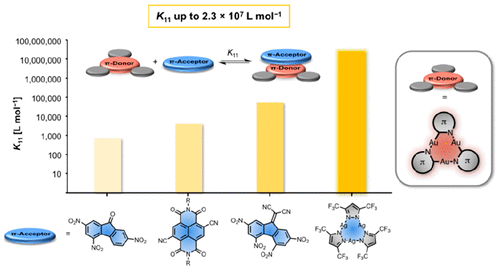Read the full paper here: J. Am. Chem. Soc., 2018, 140, 17932.

Aromatic donor–acceptor interactions are of high importance in supramolecular chemistry, materials science and biology. Compared to other noncovalent interactions, such as hydrogen bonding, the binding is often weak. Here we show that strong donor–acceptor interactions between planar aromatics with binding free energies down to −10.1 kcal mol–1 and association constants of up to 2.34 × 107 L mol–1 for 1:1 complexes can be realized using cyclic trinuclear complexes of gold(I) with pyridinate, imidazolate, or carbeniate ligands. Data were obtained through NMR and UV/vis absorption spectroscopic studies and supported by quantum chemical calculations for a variety of acceptors. By using a specifically designed bridged naphthalene diimide-based acceptor with only one binding site, we furthermore show that a 1:2 (donor:acceptor) binding model is best suited to quantify the donor and acceptor/complex equilibrium. Scanning electron microscopy on selected donor–acceptor pairs shows crystalline supramolecular assemblies. We anticipate this study to be relevant for the future design of supramolecular systems and chemical sensors and the determination of binding energies between planar donors and acceptors.